Smartphones have always generated a lot of buzz, with people obsessing over screen size, weight or how many pixels the camera has. The recent queues for the hallowed iPhone 6 are a testament to the fact that smartphones have dominated the world of personal technology for the last few years. However, there’s a contender that may be about to steal the limelight. A couple of years ago, most of us weren’t really sure what role a tablet could play in our lives, but somehow these handy devices have made themselves indispensable to a range of daily tasks.
Perhaps one of the explanations for their growing popularity and increased usage is the fact that tablets have characteristics from both smartphones and computers – creating a sort of superior hybrid device. Tablets are portable, lightweight and relatively small in size, making them perfect for a wide range of jobs such as allowing waiters to electronically take your order, or verifying your signature at the bank counter.
Arguably the most predominant group of tablet users are frequent travellers who need to work on the go. Traditional options have been either laptops, which are often too heavy and cumbersome, or smartphones, which tend to have small screens that require fiddly scrolling and are not practical for business-related functions. The tablet has therefore managed to fill this gap rather well.
Although tablets as we know them have only been around for a few years, they’ve actually been in development for over half a century. Today’s light, thin and smooth-operating tablets can trace their roots back to the ‘50s, when there were attempts to use handwriting recognition devices instead of a keyboard to input data. In the ‘60s and ‘70s, the idea of a small personal computer was being floated and research began. Primitive tablet models began to emerge in the ‘80s, as companies tried to create something small enough to be held in the hand. In the ‘90s a few more versions came into production, such as the Palm Pilot or the touch screen Intel Web Tablet. But it wasn’t until the launch of the iPad in 2010 that the first real tablet success story began, with Apple managing to combine the elements together in a way that appealed to people, from the size to the functionality.
Since then, the tablet has created a new battlefield for rival technology giants to fight over their share of the market. The long-standing smartphone rivalry of Google’s Android system versus Apple’s iOS has now been taken to a new platform – 10-12 inch HD screens. While the two have been competitively upgrading systems to iOS 8 or Android 4.4, Kit Kat, another competitor, has joined the battle. Computer and laptop companies such as Fujitsu, Lenovo and HP have also been working to produce laptops where the monitor and keyboard can be disconnected. This essentially allows users to carry both a computer and a touchscreen tablet.
All of this fierce competition is good news for business users. Manufacturers are making efforts to modify the thickness and weight of tablets to make them thinner and lighter, such as Acer’s 0.36kg Iconia Tab 8 or Sony’s 0.64cm Xperia Z2 Tablet. As a result, it’s entirely possible that we may soon be holding a paper-thin tablet during a presentation.
And it’s not just size and weight that companies are focusing on. Diversification of features from display quality to camera function is creating a much broader range of products. For example, it has been standard for a tablet to have a 2560x1600 pixel display, but new technologies such as Sony’s Triluminos (a technology aimed at creating more vivid colour on screen) will be a unique selling point for users who have higher demands in display quality. Camera function, on the other hand, has tended to hover around the five-megapixel mark, but now manufacturers are starting to create tablets with up to eight megapixels.
And while it might look a bit weird if you put a tablet to your ear and try to make a phone call, manufacturers are starting to provide a space for a phone SIM card. People are also communicating more using video-chat apps like Skype, which, with bigger screen sizes, tablets are arguably better suited to.
With increased usage driving competition between manufacturers, the quality and innovation of tablet features is bound to continue and tablets are on track to become even more mainstream in the future. With that in mind, let’s have a look at the best of what’s available right now.
APPLE IPAD AIR
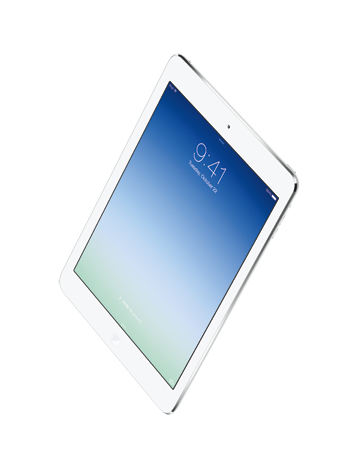 iOS; US$499
apple.com/hk/en
The fifth generation iPad device has become thinner at only 7.5mm, and weighing just 0.45kg. It has a preinstalled Apple designed 64-bit A7 processor, and is supported by 1024MB of working memory. There are four versions, with 16GB, 32GB, 64GB and 128GB of storage. The bigger the storage, the more you pay. Although the battery capacity has been reduced compared to previous generations, the device still guarantees ten hours of non-stop usage. The front camera still has a resolution of
1.3 megapixels; while the iSight camera on the back has been upgraded to five megapixels and captures high-quality snapshots in good lighting.
FUJITSU STYLISTIC Q584
iOS; US$499
apple.com/hk/en
The fifth generation iPad device has become thinner at only 7.5mm, and weighing just 0.45kg. It has a preinstalled Apple designed 64-bit A7 processor, and is supported by 1024MB of working memory. There are four versions, with 16GB, 32GB, 64GB and 128GB of storage. The bigger the storage, the more you pay. Although the battery capacity has been reduced compared to previous generations, the device still guarantees ten hours of non-stop usage. The front camera still has a resolution of
1.3 megapixels; while the iSight camera on the back has been upgraded to five megapixels and captures high-quality snapshots in good lighting.
FUJITSU STYLISTIC Q584
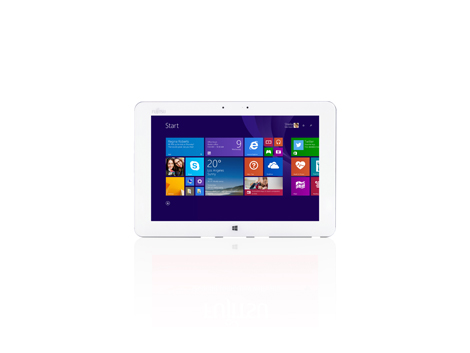 Windows; US$879
fujitsu.com
This device is designed for business users and offers common security features such as a fingerprint sensor, a Trusted Platform Module (TPM) and advanced theft protection. Individuals can work on documents using the on-screen keyboard (or buy an attachable keyboard accessory). Like other competitors, it has a high-resolution 2560x1600 pixel display. The 10.1-inch tablet is designed to be used outdoors, with a deep contrast ratio meaning the screen will still be clearly visible even in a very bright environment. This model does have a high consumption of power, but it can still run for ten hours.
MICROSOFT SURFACE PRO 3
Windows; US$879
fujitsu.com
This device is designed for business users and offers common security features such as a fingerprint sensor, a Trusted Platform Module (TPM) and advanced theft protection. Individuals can work on documents using the on-screen keyboard (or buy an attachable keyboard accessory). Like other competitors, it has a high-resolution 2560x1600 pixel display. The 10.1-inch tablet is designed to be used outdoors, with a deep contrast ratio meaning the screen will still be clearly visible even in a very bright environment. This model does have a high consumption of power, but it can still run for ten hours.
MICROSOFT SURFACE PRO 3
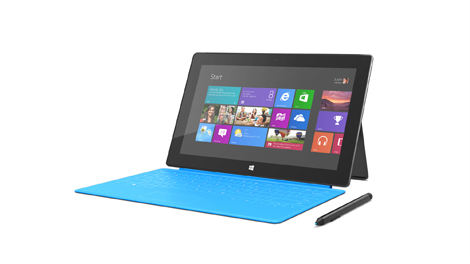 Windows; US$799
microsoft.com
Tipping the scales at 0.8kg, the 12-inch Surface Pro 3 has all the performance of a premium laptop in its thin and lightweight design. The product features a large 2160x1440 2K colour-calibrated screen in an unusual 3:2 ratio. In addition to the included keyboard, a Surface Pen is also attached allowing you to draw and take notes or to easily mark presentations, PDFs and documents – just like you would do on paper. The keyboard can also be disconnected. Both front and rear cameras are five
megapixels, enabling users to capture image stills, selfies and video chatting.
HP ELITE PAD 1000 G2
Windows; US$799
microsoft.com
Tipping the scales at 0.8kg, the 12-inch Surface Pro 3 has all the performance of a premium laptop in its thin and lightweight design. The product features a large 2160x1440 2K colour-calibrated screen in an unusual 3:2 ratio. In addition to the included keyboard, a Surface Pen is also attached allowing you to draw and take notes or to easily mark presentations, PDFs and documents – just like you would do on paper. The keyboard can also be disconnected. Both front and rear cameras are five
megapixels, enabling users to capture image stills, selfies and video chatting.
HP ELITE PAD 1000 G2
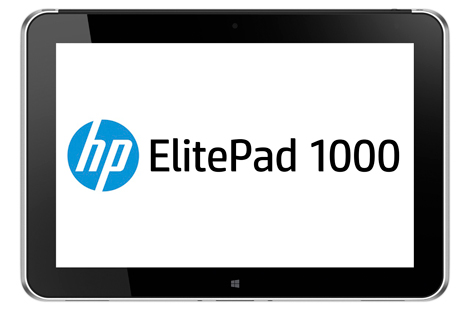 Windows; US$739
hp.com
This business-centric tablet is an upgrade over the Elite Pad 900. The 10.1-inch screen
has remained unchanged from its predecessor, but the display has improved from 1280x800 to a full-HD 1920x1200 resolution. There are two slots, a micro SD card expansion slot and the SIM card slot, allowing you to add more storage and enabling cellular connectivity. The two features make a good option for businesses requiring
on-going internet connectivity and provide more storage than the internal drive. The 0.68kg device has good heat conductivity of the metal chassis to facilitate cooling. Daily usage playing videos or browsing means the temperature will reach about 30 degrees Celsius. While under a full load, the temperature does not go over 40 degrees.
ASUS TRANSFORMER PAD TF303CL
Windows; US$739
hp.com
This business-centric tablet is an upgrade over the Elite Pad 900. The 10.1-inch screen
has remained unchanged from its predecessor, but the display has improved from 1280x800 to a full-HD 1920x1200 resolution. There are two slots, a micro SD card expansion slot and the SIM card slot, allowing you to add more storage and enabling cellular connectivity. The two features make a good option for businesses requiring
on-going internet connectivity and provide more storage than the internal drive. The 0.68kg device has good heat conductivity of the metal chassis to facilitate cooling. Daily usage playing videos or browsing means the temperature will reach about 30 degrees Celsius. While under a full load, the temperature does not go over 40 degrees.
ASUS TRANSFORMER PAD TF303CL
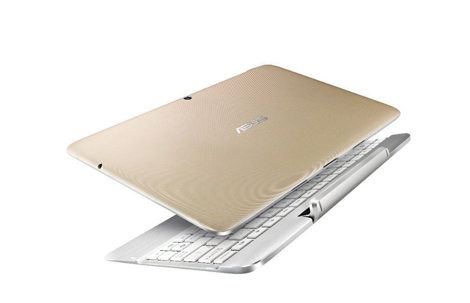 Android;€449/US567
asus.com
The Asus Transformer Pad offers a number of features that users love. Like other competitors, this model provides a full HD 10.1-inch screen with a 1920x1200 display.
The picture quality of the model may seem to be nothing special, but the rear-facing camera has a resolution of five megapixels, corresponding to the 4:3 ratio of 2560x1920 pixels, while, the second camera on the front has a maximum resolution of 1280x960 pixels (1.2 megapixels). Maximum power consumption can reach a relatively heavy 8.1 watts. You may not find it suitable for working outdoors due to its modest battery life.
Android;€449/US567
asus.com
The Asus Transformer Pad offers a number of features that users love. Like other competitors, this model provides a full HD 10.1-inch screen with a 1920x1200 display.
The picture quality of the model may seem to be nothing special, but the rear-facing camera has a resolution of five megapixels, corresponding to the 4:3 ratio of 2560x1920 pixels, while, the second camera on the front has a maximum resolution of 1280x960 pixels (1.2 megapixels). Maximum power consumption can reach a relatively heavy 8.1 watts. You may not find it suitable for working outdoors due to its modest battery life.
 iOS; US$499
apple.com/hk/en
The fifth generation iPad device has become thinner at only 7.5mm, and weighing just 0.45kg. It has a preinstalled Apple designed 64-bit A7 processor, and is supported by 1024MB of working memory. There are four versions, with 16GB, 32GB, 64GB and 128GB of storage. The bigger the storage, the more you pay. Although the battery capacity has been reduced compared to previous generations, the device still guarantees ten hours of non-stop usage. The front camera still has a resolution of
1.3 megapixels; while the iSight camera on the back has been upgraded to five megapixels and captures high-quality snapshots in good lighting.
FUJITSU STYLISTIC Q584
iOS; US$499
apple.com/hk/en
The fifth generation iPad device has become thinner at only 7.5mm, and weighing just 0.45kg. It has a preinstalled Apple designed 64-bit A7 processor, and is supported by 1024MB of working memory. There are four versions, with 16GB, 32GB, 64GB and 128GB of storage. The bigger the storage, the more you pay. Although the battery capacity has been reduced compared to previous generations, the device still guarantees ten hours of non-stop usage. The front camera still has a resolution of
1.3 megapixels; while the iSight camera on the back has been upgraded to five megapixels and captures high-quality snapshots in good lighting.
FUJITSU STYLISTIC Q584
 Windows; US$879
fujitsu.com
This device is designed for business users and offers common security features such as a fingerprint sensor, a Trusted Platform Module (TPM) and advanced theft protection. Individuals can work on documents using the on-screen keyboard (or buy an attachable keyboard accessory). Like other competitors, it has a high-resolution 2560x1600 pixel display. The 10.1-inch tablet is designed to be used outdoors, with a deep contrast ratio meaning the screen will still be clearly visible even in a very bright environment. This model does have a high consumption of power, but it can still run for ten hours.
MICROSOFT SURFACE PRO 3
Windows; US$879
fujitsu.com
This device is designed for business users and offers common security features such as a fingerprint sensor, a Trusted Platform Module (TPM) and advanced theft protection. Individuals can work on documents using the on-screen keyboard (or buy an attachable keyboard accessory). Like other competitors, it has a high-resolution 2560x1600 pixel display. The 10.1-inch tablet is designed to be used outdoors, with a deep contrast ratio meaning the screen will still be clearly visible even in a very bright environment. This model does have a high consumption of power, but it can still run for ten hours.
MICROSOFT SURFACE PRO 3
 Windows; US$799
microsoft.com
Tipping the scales at 0.8kg, the 12-inch Surface Pro 3 has all the performance of a premium laptop in its thin and lightweight design. The product features a large 2160x1440 2K colour-calibrated screen in an unusual 3:2 ratio. In addition to the included keyboard, a Surface Pen is also attached allowing you to draw and take notes or to easily mark presentations, PDFs and documents – just like you would do on paper. The keyboard can also be disconnected. Both front and rear cameras are five
megapixels, enabling users to capture image stills, selfies and video chatting.
HP ELITE PAD 1000 G2
Windows; US$799
microsoft.com
Tipping the scales at 0.8kg, the 12-inch Surface Pro 3 has all the performance of a premium laptop in its thin and lightweight design. The product features a large 2160x1440 2K colour-calibrated screen in an unusual 3:2 ratio. In addition to the included keyboard, a Surface Pen is also attached allowing you to draw and take notes or to easily mark presentations, PDFs and documents – just like you would do on paper. The keyboard can also be disconnected. Both front and rear cameras are five
megapixels, enabling users to capture image stills, selfies and video chatting.
HP ELITE PAD 1000 G2
 Windows; US$739
hp.com
This business-centric tablet is an upgrade over the Elite Pad 900. The 10.1-inch screen
has remained unchanged from its predecessor, but the display has improved from 1280x800 to a full-HD 1920x1200 resolution. There are two slots, a micro SD card expansion slot and the SIM card slot, allowing you to add more storage and enabling cellular connectivity. The two features make a good option for businesses requiring
on-going internet connectivity and provide more storage than the internal drive. The 0.68kg device has good heat conductivity of the metal chassis to facilitate cooling. Daily usage playing videos or browsing means the temperature will reach about 30 degrees Celsius. While under a full load, the temperature does not go over 40 degrees.
ASUS TRANSFORMER PAD TF303CL
Windows; US$739
hp.com
This business-centric tablet is an upgrade over the Elite Pad 900. The 10.1-inch screen
has remained unchanged from its predecessor, but the display has improved from 1280x800 to a full-HD 1920x1200 resolution. There are two slots, a micro SD card expansion slot and the SIM card slot, allowing you to add more storage and enabling cellular connectivity. The two features make a good option for businesses requiring
on-going internet connectivity and provide more storage than the internal drive. The 0.68kg device has good heat conductivity of the metal chassis to facilitate cooling. Daily usage playing videos or browsing means the temperature will reach about 30 degrees Celsius. While under a full load, the temperature does not go over 40 degrees.
ASUS TRANSFORMER PAD TF303CL
 Android;€449/US567
asus.com
The Asus Transformer Pad offers a number of features that users love. Like other competitors, this model provides a full HD 10.1-inch screen with a 1920x1200 display.
The picture quality of the model may seem to be nothing special, but the rear-facing camera has a resolution of five megapixels, corresponding to the 4:3 ratio of 2560x1920 pixels, while, the second camera on the front has a maximum resolution of 1280x960 pixels (1.2 megapixels). Maximum power consumption can reach a relatively heavy 8.1 watts. You may not find it suitable for working outdoors due to its modest battery life.
Android;€449/US567
asus.com
The Asus Transformer Pad offers a number of features that users love. Like other competitors, this model provides a full HD 10.1-inch screen with a 1920x1200 display.
The picture quality of the model may seem to be nothing special, but the rear-facing camera has a resolution of five megapixels, corresponding to the 4:3 ratio of 2560x1920 pixels, while, the second camera on the front has a maximum resolution of 1280x960 pixels (1.2 megapixels). Maximum power consumption can reach a relatively heavy 8.1 watts. You may not find it suitable for working outdoors due to its modest battery life.
SAMSUNG GALAXY TAB S10.5
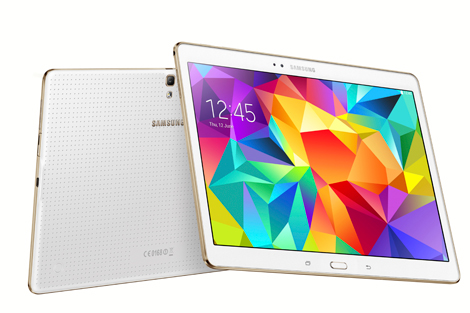 Android; US$499.99
samsung.com
Samsung’s new tablet has been receiving positive comments since its launch in June this year. It has a big 10.5-inch screen and can display 2560x1600 pixels in 16:9. Two cameras are installed in the device. The main camera on the back is a lot better than the 2.1-megapixel front camera. Featuring eight megapixels, it works in good quality by daylight, and the colour is vivid. In poor lighting conditions, the Tab S10.5 is one of the few devices equipped with a LED flash resulting in good images. In addition to the multi-user mode and fingertip security function, the model has an Ultra Power Saving Mode and works by turning your screen to black and white and shutting off non-essential apps when the battery is very low to extend the usage time.
LENOVO THINKPAD 10 MULTIMODE
Android; US$499.99
samsung.com
Samsung’s new tablet has been receiving positive comments since its launch in June this year. It has a big 10.5-inch screen and can display 2560x1600 pixels in 16:9. Two cameras are installed in the device. The main camera on the back is a lot better than the 2.1-megapixel front camera. Featuring eight megapixels, it works in good quality by daylight, and the colour is vivid. In poor lighting conditions, the Tab S10.5 is one of the few devices equipped with a LED flash resulting in good images. In addition to the multi-user mode and fingertip security function, the model has an Ultra Power Saving Mode and works by turning your screen to black and white and shutting off non-essential apps when the battery is very low to extend the usage time.
LENOVO THINKPAD 10 MULTIMODE
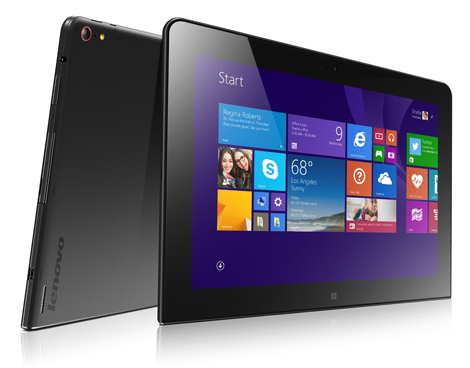 Windows; US$787.55
lenovo.com
This is basically a computer which includes an Intel Atom Z3795 processor, an Intel HD Graphics and 2048 MB memory. It could be a choice for business users, featuring the 10.1-inch screen in 1920x1200 pixels, 16:10, with ten-point multi-touch and an attached digitizer pen, enabling users to mark documents and presentations. It is light, weighing around 0.576kg, and has a long battery life of almost ten hours. Normally tablets offer a five-megapixel main camera, but the Thinkpad 10 is equipped with an eight-megapixel, autofocus rear camera with a LED flash, as well as a two-megapixel webcam.
ACER ICONIA TAB 8
Windows; US$787.55
lenovo.com
This is basically a computer which includes an Intel Atom Z3795 processor, an Intel HD Graphics and 2048 MB memory. It could be a choice for business users, featuring the 10.1-inch screen in 1920x1200 pixels, 16:10, with ten-point multi-touch and an attached digitizer pen, enabling users to mark documents and presentations. It is light, weighing around 0.576kg, and has a long battery life of almost ten hours. Normally tablets offer a five-megapixel main camera, but the Thinkpad 10 is equipped with an eight-megapixel, autofocus rear camera with a LED flash, as well as a two-megapixel webcam.
ACER ICONIA TAB 8
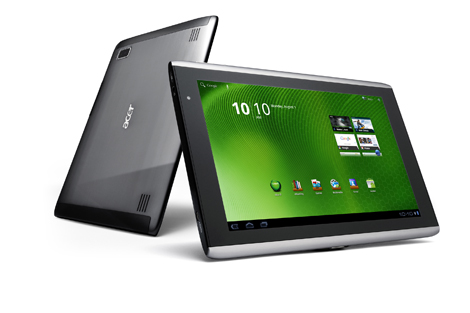 Android; US$199.99
acer.com
This tablet weighs only 0.36kg and comes with computer-like specifications such as Intel Atom Z3745 and Intel HD Graphics. The eight-inch screen has a 1920x1200 pixel Full HD display, and the tablet’s LED monitor can generate a bright enough display image which is visible in bright sunlight. The temperature remains at a maximum 37 degrees Celsius, even under a full load. Performance hungry apps such as Angry Bird Go and Real Racing 3 run fluidly due to the powerful CPU chip. The case is made of aluminium and looks sophisticated. Of course, the price is also attractive!
NVIDIA SHIELD TABLET WITH TEGRA K1
Android; US$199.99
acer.com
This tablet weighs only 0.36kg and comes with computer-like specifications such as Intel Atom Z3745 and Intel HD Graphics. The eight-inch screen has a 1920x1200 pixel Full HD display, and the tablet’s LED monitor can generate a bright enough display image which is visible in bright sunlight. The temperature remains at a maximum 37 degrees Celsius, even under a full load. Performance hungry apps such as Angry Bird Go and Real Racing 3 run fluidly due to the powerful CPU chip. The case is made of aluminium and looks sophisticated. Of course, the price is also attractive!
NVIDIA SHIELD TABLET WITH TEGRA K1
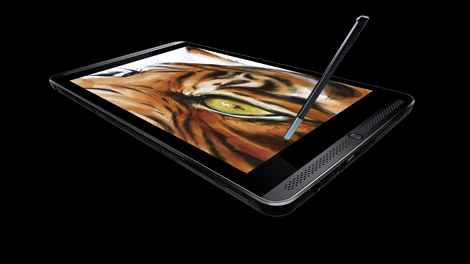 Android; US$299
shield.nvidia.com
This is definitely a good choice for those who use tablets to play games. The eight-inch monitor comes in a 1920x1200 pixel full HD display, and is an advancement compared with the 1280x800 pixels Tegra Note 7. The multi touchscreen can detect ten fingers simultaneously, yet can still display smoothly and accurately. The front-facing speakers and dual bass reflex port with built-in microphone provide good quality audio. Game Stream support is offered in order to stream games from the home PC to the tablet or TV. If you like, you can also add a wireless controller.
SONY XPERIA Z2 TABLET
Android; US$299
shield.nvidia.com
This is definitely a good choice for those who use tablets to play games. The eight-inch monitor comes in a 1920x1200 pixel full HD display, and is an advancement compared with the 1280x800 pixels Tegra Note 7. The multi touchscreen can detect ten fingers simultaneously, yet can still display smoothly and accurately. The front-facing speakers and dual bass reflex port with built-in microphone provide good quality audio. Game Stream support is offered in order to stream games from the home PC to the tablet or TV. If you like, you can also add a wireless controller.
SONY XPERIA Z2 TABLET
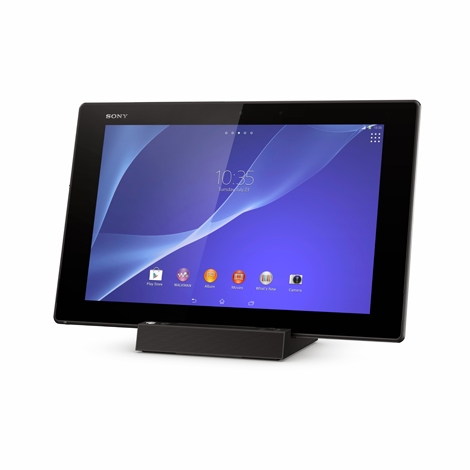 Android; US$499.99
sonymobile.com
As one of the thinnest and lightest tablets in its class, this tablet is only 0.65 cm thick and weighs less than 0.45 kg. Its 3GB memory ensures fluid performance. Not only does the 10.1-inch screen have a resolution of 1920x1200 pixels, it also uses the latest Triluminos™ technology to create more vivid colours on screen. It has an 8.1-megapixel camera and Sony does well on the battery runtime which can last for around 22 hours when the battery stamina mode is on. This model is also waterproof and dust-resistant.
Android; US$499.99
sonymobile.com
As one of the thinnest and lightest tablets in its class, this tablet is only 0.65 cm thick and weighs less than 0.45 kg. Its 3GB memory ensures fluid performance. Not only does the 10.1-inch screen have a resolution of 1920x1200 pixels, it also uses the latest Triluminos™ technology to create more vivid colours on screen. It has an 8.1-megapixel camera and Sony does well on the battery runtime which can last for around 22 hours when the battery stamina mode is on. This model is also waterproof and dust-resistant.
 Android; US$499.99
samsung.com
Samsung’s new tablet has been receiving positive comments since its launch in June this year. It has a big 10.5-inch screen and can display 2560x1600 pixels in 16:9. Two cameras are installed in the device. The main camera on the back is a lot better than the 2.1-megapixel front camera. Featuring eight megapixels, it works in good quality by daylight, and the colour is vivid. In poor lighting conditions, the Tab S10.5 is one of the few devices equipped with a LED flash resulting in good images. In addition to the multi-user mode and fingertip security function, the model has an Ultra Power Saving Mode and works by turning your screen to black and white and shutting off non-essential apps when the battery is very low to extend the usage time.
LENOVO THINKPAD 10 MULTIMODE
Android; US$499.99
samsung.com
Samsung’s new tablet has been receiving positive comments since its launch in June this year. It has a big 10.5-inch screen and can display 2560x1600 pixels in 16:9. Two cameras are installed in the device. The main camera on the back is a lot better than the 2.1-megapixel front camera. Featuring eight megapixels, it works in good quality by daylight, and the colour is vivid. In poor lighting conditions, the Tab S10.5 is one of the few devices equipped with a LED flash resulting in good images. In addition to the multi-user mode and fingertip security function, the model has an Ultra Power Saving Mode and works by turning your screen to black and white and shutting off non-essential apps when the battery is very low to extend the usage time.
LENOVO THINKPAD 10 MULTIMODE
 Windows; US$787.55
lenovo.com
This is basically a computer which includes an Intel Atom Z3795 processor, an Intel HD Graphics and 2048 MB memory. It could be a choice for business users, featuring the 10.1-inch screen in 1920x1200 pixels, 16:10, with ten-point multi-touch and an attached digitizer pen, enabling users to mark documents and presentations. It is light, weighing around 0.576kg, and has a long battery life of almost ten hours. Normally tablets offer a five-megapixel main camera, but the Thinkpad 10 is equipped with an eight-megapixel, autofocus rear camera with a LED flash, as well as a two-megapixel webcam.
ACER ICONIA TAB 8
Windows; US$787.55
lenovo.com
This is basically a computer which includes an Intel Atom Z3795 processor, an Intel HD Graphics and 2048 MB memory. It could be a choice for business users, featuring the 10.1-inch screen in 1920x1200 pixels, 16:10, with ten-point multi-touch and an attached digitizer pen, enabling users to mark documents and presentations. It is light, weighing around 0.576kg, and has a long battery life of almost ten hours. Normally tablets offer a five-megapixel main camera, but the Thinkpad 10 is equipped with an eight-megapixel, autofocus rear camera with a LED flash, as well as a two-megapixel webcam.
ACER ICONIA TAB 8
 Android; US$299
shield.nvidia.com
This is definitely a good choice for those who use tablets to play games. The eight-inch monitor comes in a 1920x1200 pixel full HD display, and is an advancement compared with the 1280x800 pixels Tegra Note 7. The multi touchscreen can detect ten fingers simultaneously, yet can still display smoothly and accurately. The front-facing speakers and dual bass reflex port with built-in microphone provide good quality audio. Game Stream support is offered in order to stream games from the home PC to the tablet or TV. If you like, you can also add a wireless controller.
SONY XPERIA Z2 TABLET
Android; US$299
shield.nvidia.com
This is definitely a good choice for those who use tablets to play games. The eight-inch monitor comes in a 1920x1200 pixel full HD display, and is an advancement compared with the 1280x800 pixels Tegra Note 7. The multi touchscreen can detect ten fingers simultaneously, yet can still display smoothly and accurately. The front-facing speakers and dual bass reflex port with built-in microphone provide good quality audio. Game Stream support is offered in order to stream games from the home PC to the tablet or TV. If you like, you can also add a wireless controller.
SONY XPERIA Z2 TABLET
 Android; US$499.99
sonymobile.com
As one of the thinnest and lightest tablets in its class, this tablet is only 0.65 cm thick and weighs less than 0.45 kg. Its 3GB memory ensures fluid performance. Not only does the 10.1-inch screen have a resolution of 1920x1200 pixels, it also uses the latest Triluminos™ technology to create more vivid colours on screen. It has an 8.1-megapixel camera and Sony does well on the battery runtime which can last for around 22 hours when the battery stamina mode is on. This model is also waterproof and dust-resistant.
Android; US$499.99
sonymobile.com
As one of the thinnest and lightest tablets in its class, this tablet is only 0.65 cm thick and weighs less than 0.45 kg. Its 3GB memory ensures fluid performance. Not only does the 10.1-inch screen have a resolution of 1920x1200 pixels, it also uses the latest Triluminos™ technology to create more vivid colours on screen. It has an 8.1-megapixel camera and Sony does well on the battery runtime which can last for around 22 hours when the battery stamina mode is on. This model is also waterproof and dust-resistant.








